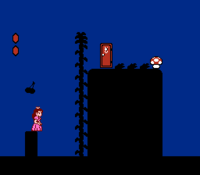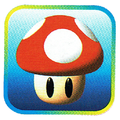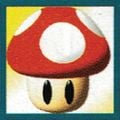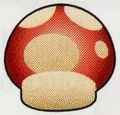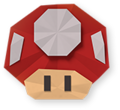Mushroom
- This article is about the Mushrooms that heal Mario's Heart Points in RPG games, among miscellaneous uses. For other uses, see Mushroom (disambiguation).
- "Shroom" redirects here. For the enemy in Donkey Kong 64, see Shroom (enemy).
- Not to be confused with Super Mushroom or Dash Mushroom.
| Mushroom | |
|---|---|
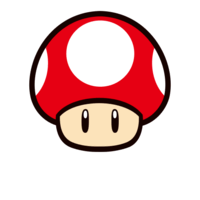 Artwork from Mario Party Superstars | |
| First appearance | Super Mario Bros. 2 (1988) |
| Latest appearance | Mario Strikers: Battle League (2022) |
| Effect | Restores HP (RPG games) Allows a player to roll 2 dice blocks (Mario Party series) |
Template:Quote2 Mushrooms are recurring items in the Mario franchise. Their effect on the player character varies from game to game. They commonly share an appearance with the Super Mushrooms from the Super Mario series and Dash Mushrooms from the Mario Kart series.
History
Super Mario Bros. 2
Mushrooms,[1] also known as Sub-space Mushrooms[2] or Subspace Mushrooms,[3] add an additional mark or heart to the life meter, up to four. Additionally, the Mushrooms also turn Mario, Luigi, Peach, and Toad back into their Super forms if they are in their Small forms in the same manner as a Super Mushroom or a small heart, and the health meter is refilled upon collection. Mushrooms are found only in specific Subspace locations within the stage.
In Super Mario Advance, an extra mushroom is added to each level, bringing the maximum total to five hearts. During the Yoshi Challenge, two mushrooms in each level are replaced by Yoshi Eggs.
The equivalent to the mushrooms in Yume Kōjō: Doki Doki Panic are hearts.
Mario Clash
In Mario Clash, defeating thirty target enemies will cause a Mushroom to spawn from the pipes. This item will initiate Fever Time, which allows Mario to defeat any enemy with a single throw and doubles all points. The effect ends if Mario loses a life or the shell and when he finishes the stage.
Super Mario RPG: Legend of the Seven Stars
In Super Mario RPG: Legend of the Seven Stars, a basic Mushroom can be accumulated in the inventory and recovers 30 HP for one party member. This Mushroom has a red and white cap with an orange stem and no face. However, mushrooms that have faces are found in treasure boxes, and they automatically recover all HP and FP for Mario's entire party once uncovered. Most of these treasure boxes restock once the area is entered again. Other types of mushrooms exist, including two other increasingly expensive kinds used for basic recovery. The Mid Mushroom recovers 80 HP to one party member, and they have a green cap rather than a red one. The Max Mushroom is able to recover all HP to one party member and has a yellow cap. In the Japanese version, the Mid Mushroom and Max Mushroom are respectively known as Super Mushroom and Ultra Mushroom, which would become the terminology used in future RPGs.
There are mushrooms indistinguishable in appearance but instead cause negative effects on allies and adversaries alike. The Bad Mushroom, only found in Seaside Town, does not recover HP and is used only in battle. When used, they poison an enemy of choice, but some enemies are resistant. Another mushroom is sold by the Goombette Triplets at the shop in Monstro Town. These mushrooms, apart from restoring 30 HP, actually turn the user into a Mushroom (a status ailment also caused by certain enemy actions). While a mushroom, the character recovers health every turn, but is completely immobilized.
Mario Party series
Mushrooms appear as items in the Mario Party series. The first time they appear is in Mario Party 2 (where they are Mario's favorite item), and they have reappeared in other Mario Party titles. In Mario Party 4, Mario Party DS, and Mario Party 8, the item is not present (although there are similar items, such as Mario Party 4's Mega Mushroom, and Mario Party 8's Twice Candy). They allow for two rolls of the Dice Block during one turn. If the two digits rolled are the same, the user will receive ten Coins. If the user happens to roll two 7's, they will receive twenty Coins. If players want to purchase this item, the price will usually be five Coins.
In Mario Party Advance, their effect is different. In this installment, Mushrooms allow the player to roll the Dice Block. Each turn, a Mushroom will be depleted from the stock. For players to win Mushrooms, they have to win minigames. Players will usually receive three Mushrooms when they win a minigame, although there are cases in which the award for winning a minigame will be six Mushrooms. The game ends when the player doesn't have any Mushrooms left.
In Mario Party 9, Mushrooms appear in the Fungi Frenzy minigame, where 1-3 of them are contained in each panel.
In Mario Party 10, they appear in the minigame Movin' Mushrooms. If it falls into a cart, the respective team gains one point.
In Mario Party Superstars, Mushrooms return as items, costing 3 Coins to purchase. Due to their role of providing a second Dice Block being supplanted by the Double Dice, Mushrooms instead function similarly to Dash Mushrooms and Golden Dash Mushrooms in Mario Party: Island Tour, Mario Party: Star Rush, Mario Party: The Top 100, and Super Mario Party, adding five spaces to the user's dice roll.
Mario Tennis series
Mushrooms appear in the games Mario Tennis for the Nintendo 64, and Mario Power Tennis for the Nintendo GameCube and Wii. These staples can be used during an Item Battle match, which can be obtained when the player hits an Item Box with the ball over the net. In both games, Mushrooms make players run faster, but in the latter game, they can also grow players who have been shrunk by lightning back to normal size. In Mario Tennis Open for the Nintendo 3DS, tennis gear for Miis is designed based on a Mushroom. It is the emblem of the Mushroom Cup for all the previously mentioned games.
Paper Mario series
| Mushroom | |
|---|---|
| Paper Mario description | A regular Mushroom. Restores 5 HP. |
| The Thousand-Year Door description | A feel-good mushroom. Replenishes 5 HP. |
Paper Mario
In Paper Mario, Mushrooms act as healing items, as in other Mario RPGs. In this game, they heal 5 HP when used. Several variations of Mushrooms can be found, such as Volt Shrooms and Life Shrooms. Recipes can also be made for other types of Mushrooms by combining certain ingredients together by Tayce T.
Paper Mario: The Thousand-Year Door
Mushrooms return in Paper Mario: The Thousand-Year Door. They heal in the same manner as in the previous game, with the addition that - now that Mario's partners have HP - mushrooms can restore a partner's HP also.
The many variations of Mushrooms from the previous game return, with the addition of Slow Shrooms. Small creatures named Punies commonly eat Mushrooms, shown by brother and sister Punio and Petuni. At the end of the game, Punio and Petuni give both Mario & Peach a Mushroom to enjoy on their boat ride home.
Super Paper Mario
Unlike in the preceding games, Mushrooms cannot be bought in shops in Super Paper Mario. Instead, they are found out of ? Blocks and heal ten HP upon contact. They also give the player 1000 points. Their carry-on equivalent is the Shroom Shake.
Paper Mario: Sticker Star
In the fourth game of the Paper Mario series, Paper Mario: Sticker Star, Mushrooms appear, much like every other item, as stickers. They restore 20 HP, but if the button is pressed with good timing, the effect can be increased to 30. Two stronger Mushroom stickers also exist: the Shiny Mushroom, which acts like a Super Shroom, which restores 40 or 60 HP, and the Flashy Mushroom, which acts like an Ultra Shroom, which restores 80 or 99 HP. Big 1UP and Big Shiny 1UP stickers also appear, restoring 10 or 15 HP for 10 turns, respectively, as do Poison Mushrooms, which poison Mario, but enemies also get poisoned if they touch him.
Paper Mario: Color Splash
In Paper Mario: Color Splash, Mushrooms appear as cards. They use up red paint when colored in, restore a small amount of HP when used, and cost 20 coins at Prisma Cardware. In addition to regular Mushrooms, Big Mushroom and Mega Mushroom cards also appear, which cost 70 and 150 coins respectively and restore more HP.
Paper Mario: The Origami King
- “Who likes Mushrooms? ME!”
- —Toad, Paper Mario: The Origami King
Mushrooms reprise their roles in Paper Mario: The Origami King, with their Shiny and Flashy variants returning from Sticker Star. This time, however, they don't appear as stickers, but in a physical, papercraft form. The regular mushroom is the most common and heals 50 HP, while the Shiny version heals 100 HP. When used in battle, they will occupy one of Mario's attack slots. All three variants can be found in ? Blocks throughout the game, and after one is found in the world, it then becomes available at Toad Town's item shop. They can also be bought at Overlook Tower and Big Sho' Theater. Mario can hold up to 99 Mushrooms, and unlike in the previous two games, they can be used outside of battle in almost any area. However, they are banned from Scuffle Island, cannot be used while riding down Eddy River, and will be burned by a Fire Vellumental statue when fighting the Paper Macho Shy Guys in the Fire Vellumental Cave. The Mushroom 3-Pack and Mushroom 6-Pack (which have Shiny variants of their own) are bulk items that can be bought in stores for a cheaper price than buying Mushrooms individually.
Recipes
| Recipe | Result of Cooked Item | Game that Recipe is in |
|---|---|---|
| Egg + Mushroom | Bland Meal | Paper Mario |
| Mushroom + (Koopa Leaf, Goomnut or Strange Leaf) | Volt Shroom | |
| Mushroom | Fried Shroom | |
| Mushroom + Honey Syrup | Honey Shroom | Paper Mario and Paper Mario: The Thousand-Year Door |
| Mushroom + Maple Syrup | Maple Shroom | |
| Mushroom + Jammin' Jelly | Jelly Shroom | |
| Mushroom + Cake Mix | Shroom Cake | |
| Mushroom + Life Shroom | Shroom Steak | |
| Mushroom + Thunder Rage | Volt Shroom | Paper Mario: The Thousand-Year Door |
| Mushroom + Mr. Softener | Dried Shroom | |
| Mushroom + Point Swap | Honey Syrup | |
| Mushroom + Mystic Egg | Omelette Meal | |
| Mushroom + Fire Flower | Shroom Roast | |
| Mushroom + Turtley Leaf | Shroom Fry | |
| Mushroom | Shroom Fry |
Mario & Luigi series
Mario & Luigi: Superstar Saga / Mario & Luigi: Superstar Saga + Bowser's Minions
Mushrooms are the basic item for healing in Mario & Luigi: Superstar Saga. They are the cheapest item found in stores and the first item obtained. Their coloring is reversed in this game, with their caps being white with red spots; they also lack faces. Regular Mushrooms restore 25 HP, Super Mushrooms restore 50 HP, Ultra Mushrooms restore 120 HP, and Max Mushrooms restore all HP. Five special Golden Mushrooms can also be found in the game; the rare item restores all HP and BP. Shroom Badges and Shroom clothings that can be purchased at certain shops will increase Mario and Luigi's stats according to the number of Mushrooms in their inventory.
A unique mushroom called the Invincishroom (claimed to be a mix of 1-Up Mushrooms and Stars, but in the remake, it was actually a Poison Mushroom, as confirmed in the Minion Quest side mode) can be found only when the player has beaten the high score of a certain minigame. The player cannot use it, however, because Mario eats it as soon as he and Luigi win it, causing him to become very sick and slowly turn into a bean. Luigi cures Mario by giving him Crabbie Grass, which is found in Guffawha Ruins.
In Mario & Luigi: Superstar Saga + Bowser's Minions, regular Mushrooms heal 30 HP instead of 25 HP, Ultra Mushrooms heal 80 HP instead of 120 HP, and their designs are changed to be the standard design, as in the other Mario & Luigi games.
Mario & Luigi: Partners in Time
In Mario & Luigi: Partners in Time, Mushrooms act in the same manner as in Mario & Luigi: Superstar Saga; they restore HP for one member. While the Max Mushroom is still the same, the regular, Super, and Ultra Mushrooms heal 20 HP, 40 HP, and 80 HP, respectively. There are also items called Mushroom Drops, which will heal every single member on the team, very much like the Nuts in Mario and Luigi: Superstar Saga. Unlike Max Mushroom and Max Nuts, however, there is nothing more powerful than Ultra Drops. Shroom Badges make a return, but with a different effect: they now increase the healing effects of a Mushroom.
Shroobs, the main enemies in this game, bear a resemblance to Mushrooms. They have the same mushroom shape and spots, and they even live on a planet shaped like a mushroom.
Mario & Luigi: Bowser's Inside Story / Mario & Luigi: Bowser's Inside Story + Bowser Jr.'s Journey
Mushrooms return in Mario & Luigi: Bowser's Inside Story and its remake, but Mushroom Drops are replaced in favor of the original Mario & Luigi series Nuts. Mushrooms act in the same manner as in the two preceding games. Mushrooms in this game heal 30 HP, Super Mushrooms heal 60 HP, Ultra Mushrooms 120 HP, and Max Mushrooms heal 240 HP instead of all HP like in the previous installments.
Also, there was a clothing item called the Mushroom Glove, which would have a random mushroom be consumed every turn to the one wearing the glove.
Bowser does not eat mushrooms unless a Goomba/Bob-omb from a Jailgoon or the Broque Monsieur "fight", a Trashure or Dark Trashure, or a Naplock gives him one, or he uses Refreshrooms, which recover half of his Health Meter (only when he is Giant Bowser).
Mario & Luigi: Dream Team
Mushrooms return in Mario & Luigi: Dream Team. Regular Mushrooms heal 30 HP, Super Mushrooms heal 60 HP, Ultra Mushrooms heal 100 HP, and Max Mushrooms heal 160 HP. If Shroom EXP is used, then the value of the HP healed from using Mushrooms during battle will be converted to EXP at the end, but with a 50% bonus. Regular Mushrooms add 45 EXP, Super Mushrooms add 90, Ultra Mushrooms add 150, and Max Mushrooms add 240.
The game also introduces a special technique that involves the use of Mushrooms called Rhythm Mushroom, which is exclusive to giant battles.
Mario & Luigi: Paper Jam
Mushrooms return in Mario & Luigi: Paper Jam. Just like in the previous game, the four types are regular (+30 HP), Super (+60 HP), Ultra (+100 HP) and Max (+160 HP).
Mario Golf: World Tour
Mushrooms appear in Mario Golf: World Tour as usable item shots. They make the ball roll much farther when they hit the ground. They are also seen as tee markers on the Toad Highlands golf course. Trophies for Castle Club tournaments, and the lampposts of the building's exterior, have models of Mushrooms. The Mushrooms are red on regional tournament trophies and their spots are the trophy's color, while on world tournament trophies, the Mushrooms have crowns on them and are completely colored like the rest of the trophy.
Mario + Rabbids Kingdom Battle
Mushrooms appear in Mario + Rabbids Kingdom Battle as healing items between battles during levels. Once collected, they heal all active party members 70 HP. The amount of HP healed to Mario can be upgraded via the skill tree, although it remains unchanged for other party members.
WarioWare: Get It Together!
In the microgame Inside the Storm in WarioWare: Get It Together!, one of the objects Wario spits out is a yellow Mushroom with Wario's mustache and no eyes.
Profiles
Super Mario Bros. 2
- Wii Virtual Console manual bio: This item replenishes your life meter and extends it by one mark (up to a maximum of four marks).
Mario & Luigi: Dream Team
- Digital instruction manual bio: Recovers the HP of one character.
Paper Mario: The Origami King
- Description: A useful item that can restore Mario's health anytime.
- Collectible Treasure #2: Another valuable resource for restoring Mario's HP. A Mushroom a day keeps game overs at bay!
Gallery
- See also: Gallery:Super Mushroom
Artwork
Super Mario All-Stars (Super Mario Bros. 2)
Sprites and models
Names in other languages
| Language | Name | Meaning | Notes |
|---|---|---|---|
| Japanese | キノコ / きのこ[4][5] Kinoko |
Mushroom | |
| Chinese (simplified) | 蘑菇 Mógu 加血蘑菇[6] (Super Mario Advance) Jiāxiě Mógu |
Mushroom Add Heart Point Mushroom |
|
| Dutch | Paddenstoel[?] | Mushroom | |
| German | Pilz[?] | Mushroom | |
| Italian | Fungo[?] | Mushroom | |
| Korean | 버섯[?] Beoseot |
Mushroom | |
| Portuguese | Cogumelo[?] | Mushroom | |
| Russian | Гриб[?] Grib |
Mushroom | |
| Spanish | Champiñón[?] | Mushroom |
References
- ^ Super Mario Bros. 2 instruction booklet. Page 19.
- ^ Super Mario All-Stars Player's Guide. Template:Media link.
- ^ Nintendo Power Advance Volume 1. Page 14.
- ^ Super Mario Collection instruction booklet, Super Mario USA section.
- ^ Mario Clash Japanese instruction booklet, page 17.
- ^ iQue's promotional demo play videos of Super Mario Advance and Wario Land 4. Retrieved Febuary 9, 2020.
- Mushrooms
- Ingredients
- Heads-Up
- Mario & Luigi: Bowser's Inside Story items
- Mario & Luigi: Bowser's Inside Story + Bowser Jr.'s Journey items
- Mario & Luigi: Dream Team items
- Mario & Luigi: Paper Jam items
- Mario & Luigi: Partners in Time items
- Mario & Luigi: Superstar Saga items
- Mario Golf: World Tour items
- Mario Hoops 3-on-3 items
- Mario Party 2 items
- Mario Party 3 items
- Mario Party Advance items
- Mario Party Superstars items
- Mario Strikers Charged items
- Mario's Picross
- Mario's Time Machine items
- Paper Mario items
- Paper Mario: Color Splash items
- Paper Mario: Sticker Star items
- Paper Mario: The Origami King items
- Paper Mario: The Thousand-Year Door items
- Super Mario Advance items
- Super Mario Bros. 2 items
- Super Mario RPG: Legend of the Seven Stars items
- Super Mario Strikers items
- Super Paper Mario items
